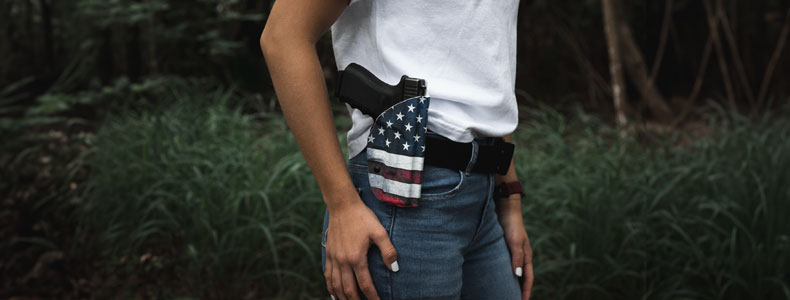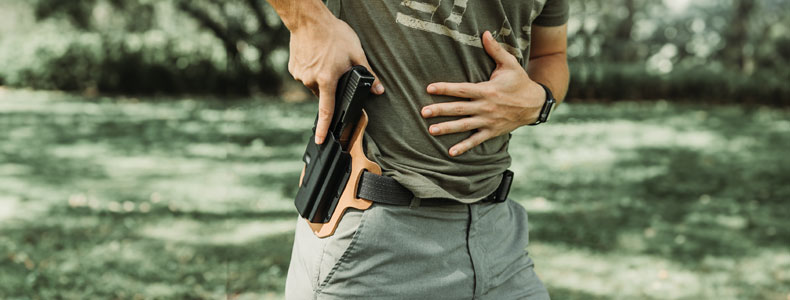How to Wear an OWB Holster for Concealed Carry

Outside the waistband – or “OWB” – holsters are an excellent choice for both open and concealed carry. These commonly-used holsters are carried on the outside of your waistband and are known for being one of the most comfortable carry options available.
There are countless reasons to use an OWB holster for concealed carry. They are incredibly easy to draw from and make carrying larger guns one of the safest and most comfortable holster choices.
If you’re thinking about trying OWB concealed carry, look no further. This guide will walk you through the ins and outs of concealing an outside the waistband holster and help you determine whether it’s the right move for you.
Products Mentioned In This Article
What is an OWB Holster?
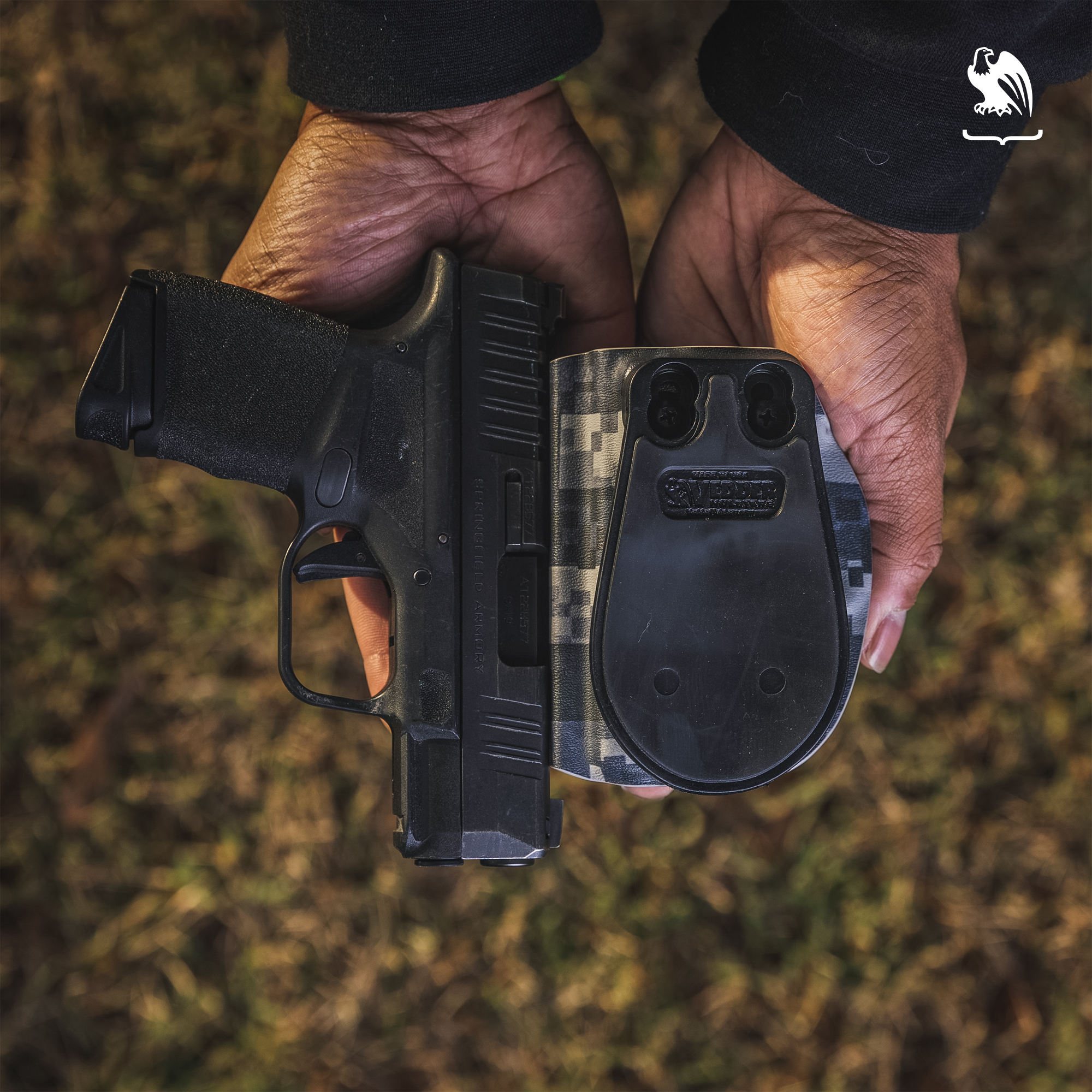
OWB holsters are carried on the outside of your waistband (duh). They are designed with clips, loops, or slits that allow you to secure your holster to the outside of your belt, where you can then cover it with a jacket or use it to open carry.
Outside the waistband is considered one of the most comfortable carry positions since the gun makes little to no contact with your body.
OWB is also considered one of the safest carry options as it keeps a few extra inches of separation between you and your weapon in the event of a negligent or accidental discharge.
Carrying OWB also enables you to conceal larger pistols more comfortably and makes drawing your firearm easier since there are fewer layers between you and your handgun (most of the time).
Can You Conceal OWB?
While it’s true that most of the time OWB is used for open carry, if you wear the right clothing, you can absolutely conceal an OWB setup.
Concealing outside the waistband is more complicated than concealing inside the waistband because you have to worry about hiding your entire gun instead of the little bit that sticks out when carrying IWB. Carrying OWB also means your weapon isn’t held as close to your body, which can pose a problem when it comes to printing.
The key to successfully concealing OWB is layers and loose clothing. A light jacket, cardigan, vest, or even a loose-fitting flannel shirt can all get the job done. Investing in an OWB holster for concealed carry that holds your pistol closer to your body and wearing a quality gun belt to prevent sagging will also help you keep a low profile.
Check out our article here to learn about the differences between OWB vs. IWB for concealed carry.
Is OWB Carry Safe?
Like any carry setup, your level of safety while carrying OWB will all depend on how often and how well you train. However, outside the waistband carry is generally considered safer than other alternatives because it offers a little more space between your handgun and your body.
In a video for Brownells, firearms trainer Jeff Gonzales said he usually recommends new concealed carriers start out carrying OWB because the risk of injury is lower in the event of a negligent or accidental discharge.
“If that [negligent discharge] were to happen with an off waistband, I have the firearm a little bit further away from my body than I would if it were inside the waistband,” he said. “I’m not saying that you can’t have an accidental discharge with an on-the-waistband vs. an in-the-waistband, but it typically starts off on a much safer platform.”
So, if you’re concerned with safety (which you should be!), starting out with an OWB holster may be a good idea if you’re new to the world of CCW.
Are OWB Holsters Comfortable?
Comfort is an essential part of concealed carry, and if you’re thinking about carrying outside the waistband, you’re probably wondering if it will be a comfortable option. The short answer to this question is: yes, OWB is known as one of the most comfortable concealed carry methods, though some people feel more mentally comfortable with other options.
Factors like your body type, lifestyle, holster, and carry position can all affect the comfort of an OWB setup.
When carrying OWB, your gun and holster make little to no direct contact with your body, making it one of the safest and most comfortable options available. However, OWB may or may not be the best option for you when it comes to mental comfort.
Because an outside the waistband holster is harder to conceal, some people find themselves constantly worried about printing or revealing their gun. So, while OWB certainly excels in terms of physical comfort, some people would rather experience the mental comfort of a more easily-concealed position.
Either way, the comfort level you experience while carrying OWB has a lot to do with the type of holster you wear and the position you carry in.
Downsides to Outside the Waistband Carry
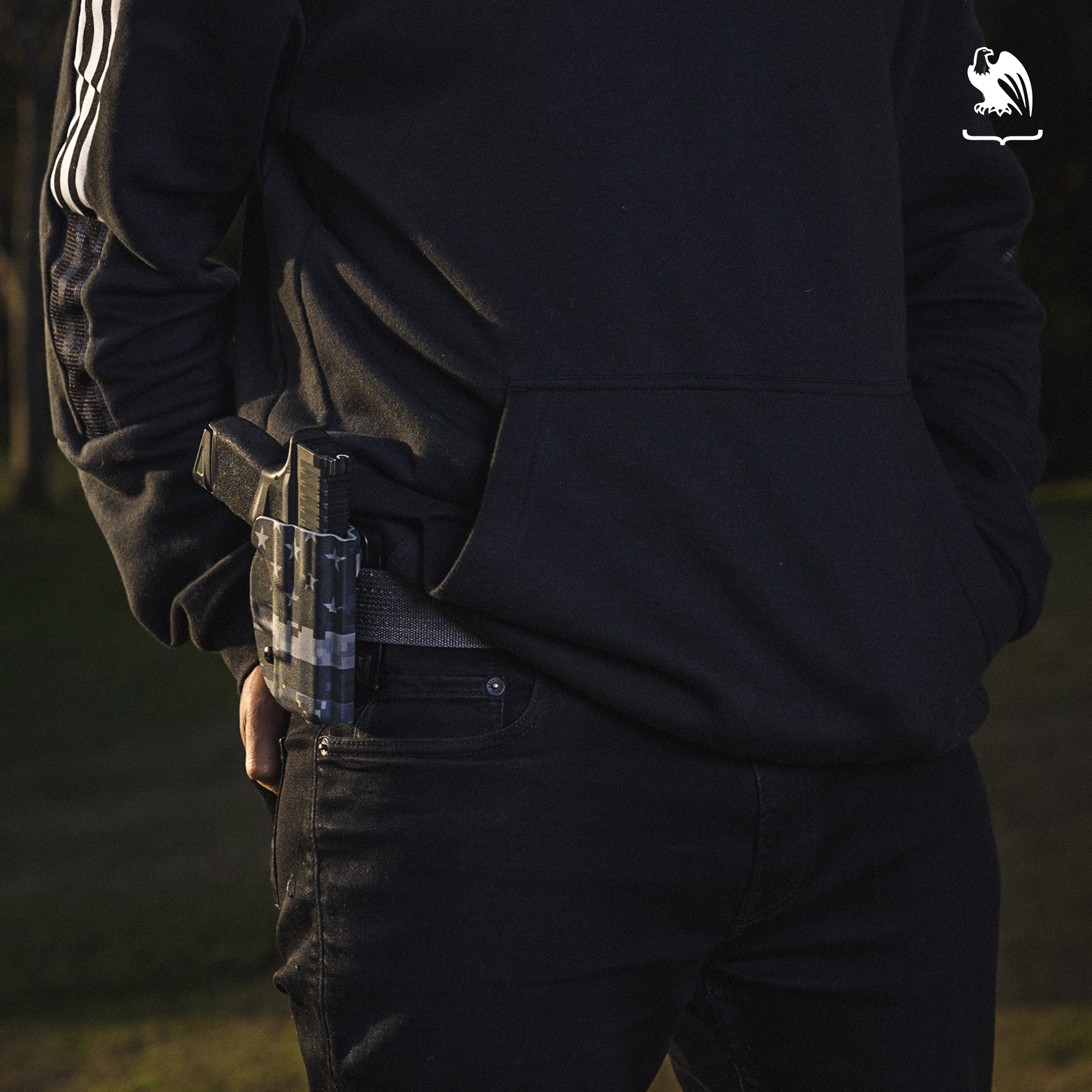
Though there are many reasons why people love carrying OWB, there are a few drawbacks to the carry method.
The first disadvantage to OWB is the concealability factor. While you can absolutely conceal carry outside the waistband, it does require a little more finesse when it comes to your wardrobe.
The best way to conceal an OWB holster is with a coat, jacket, or vest, which poses an issue during the warmer months. This can be problematic even in the winter if you’re planning to go into a warm building where you will be tempted to remove your outer layers.
Not only that, but the heftier clothing required to successfully conceal an OWB holster make drawing your weapon that much harder because you have thicker, heavier layers to move out of your way.
Another issue with OWB is that even if you manage to conceal your gun, you’ll be much more susceptible to printing, meaning it’s more likely that others will notice you’re carrying.
While these factors should be considered, they shouldn’t necessarily deter you from trying OWB if that’s how you want to carry. There is no such thing as a perfect system, and as long as you’re aware of the potential downsides to OWB carry and take the steps necessary to prevent them, it should work for you.
Types of OWB Holsters
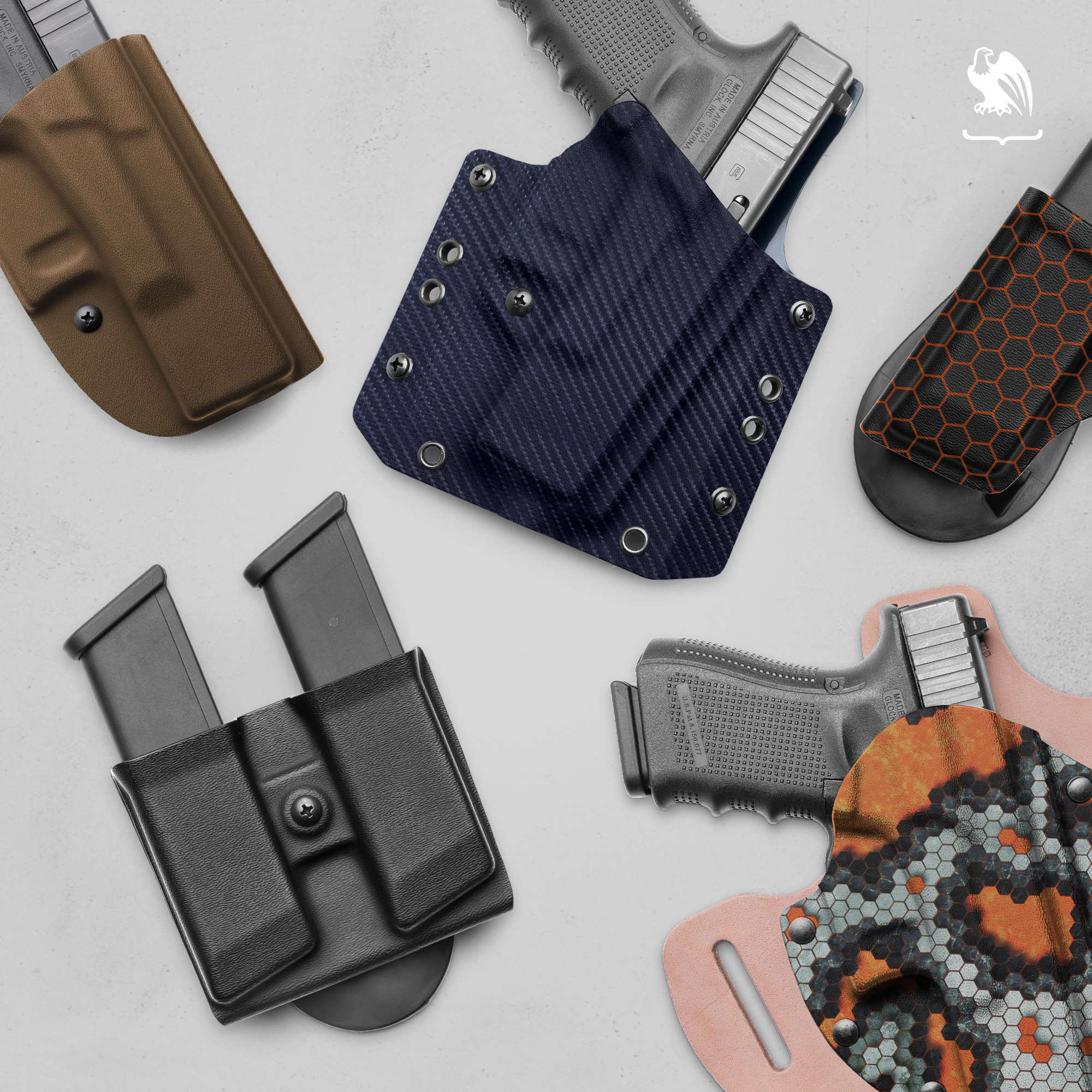
There are several types of holsters to choose from in the world of OWB. Outside waistband concealed carry holsters are crafted with clips, loops, or slits that allow you to attach the holster to your belt from outside your waistband. A few of the most common designs you’ll come across are the pancake, paddle, and belt slide-style holsters.
Pancake holsters are made with two pieces of material that are sewn together to create a flat pouch that “pancakes” against your body. Because of how slimly they are designed, they make an excellent choice for concealed carry.
Paddle holsters are one of the best OWB holster for concealed carry options. These holsters have a flat, wide paddle-style clip that comfortably tucks inside your waistband. Unlike most OWB holsters, which are slid onto your belt before you put it on, paddle holsters can be conveniently attached and removed without taking off your belt. Our ProDraw™ paddle holster is a popular OWB choice.
Finally, belt slide holsters are essentially a sleeve of material that slides onto your belt. They cover only a portion of your gun, leaving the muzzle exposed. While their slim design makes them easy to conceal, some criticize them for not being as protective as other holster styles.
When it comes to choosing a quality OWB holster, one of the most important elements to look at is its clips. Our Vedder Holsters LightDraw™ OWB holster can be ordered with optional Pancake Wing clips designed to help your holster lay flat against your body, making concealing OWB easier.
We offer a multitude of Kydex and hybrid OWB concealment holster styles here at Vedder Holsters, all of which can be viewed on our website here.
Outside the Waistband Carry Positions
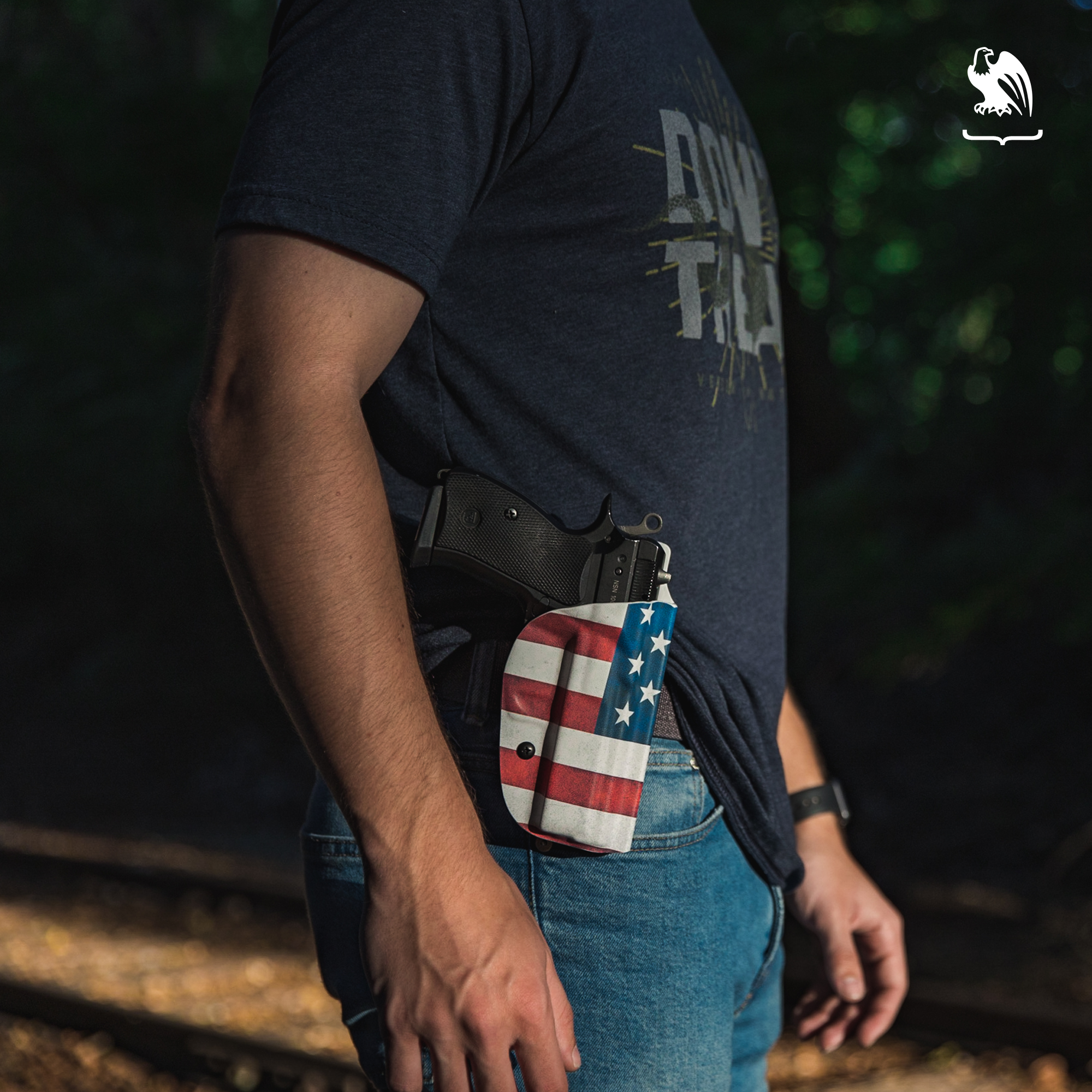
There are many, many different ways to carry OWB. The position that’s best for you will come down to your lifestyle, preferences, and body type. Everyone is different, and it may take a few tries to figure out which carry position works best for you.
When talking about carry positions, we often use the hours on a clock as a reference. Since our bodies are somewhat round, you can imagine yourself standing on a clock face with your naval pointed to the 12 o’clock position, your back facing 6 o’clock, and your hips pointing to 3 and 9 o’clock.
When it comes to carry positions, there aren’t many hard and fast rules. You can try carrying at any position you find comfortable, even if that means carrying at 2:45 o’clock, 3:30 o’clock, or whatever feels right (no judgment here). Because of the nature of OWB, your carry position options are more limited than with IWB carry. For example, most people tend not to carry OWB appendix or at the 12 o’clock position simply because it becomes almost impossible to conceal.
It is important to note that many OWB holsters are not adjustable, which may limit your options when it comes to positioning. The majority of them are already designed with an FBI cant, however, so they’re still easy to draw from and conceal. If you are looking for an OWB concealment holster with adjustable cant, our ProDraw™ Paddle Holster is an excellent choice.
There are a few common carry positions that tend to work well for OWB:
Strong-Side Carry (3 o’clock): Strong-side carry is the most commonly-used OWB position, especially for open carry.
Strong-side is located at the 3 o’clock position (9 o’clock for lefties) and is easily accessible to your dominant hand. Because of its convenient location, it allows you to quickly access your pistol if necessary.
The only downside to this position is how difficult it is to conceal. Because it sits right on your hip, it tends to stick out more than most other positions, making it really challenging to hide under a lightweight shirt – especially for heavier-set people. This position can also become uncomfortable after long periods since it sits right on your hip bone.
Kidney Carry (4-5 o’clock): Kidney carry, located at 4-5 o’clock, or 7-8 o’clock if you’re left-handed, is another good OWB carry position. In this position, your gun rests just behind your hip, making it fairly easy to conceal.
Kindey carry can be a bit awkward for some, as the position is somewhat difficult to draw larger handguns from. This can be remedied by either carrying a smaller pistol or tilting your holster’s cant so that the grip of your firearm is pointing toward your hip for easier access.
Small-of-Back (5-6 o’clock): Small of back carry, or 6 o’clock carry, is another common carry position. While small of back is one of the more comfortable and easy-to-conceal positions, most experts do not recommend it as there are several dangerous hazards associated with it.
First, drawing from 6 o’clock is incredibly difficult. It forces you to position both your hands behind your back to draw (one to grip the gun and one to move your clothes) and puts you at higher risk of flagging yourself or someone else while bringing it around to the front of your body.
However, one of the biggest issues with this position is its placement right on your spine. If you were to fall while carrying small of the back, the risk of serious spinal injury is incresaed dramatically.
To learn more about small of back carry and its potential drawbacks, read our article all about it here.
Cross Draw (10-11 o’clock): Cross draw carry – 10-11 o’clock for right-handed shooters and 1-3 o’clock for lefties – means your weapon is positioned on your weak side’s hip with the grip of your gun facing your dominant hand. To draw from this position, you must cross your arm over your body.
Like strong side carry, cross draw is an effective but difficult-to-conceal position. Drawing from the cross draw position can be made more accessible by adjusting your negative cant so that your grip faces your belly button. Cross draw requires a lot of extra practice to ensure you don’t muzzle yourself or someone else while drawing.
How To Draw OWB
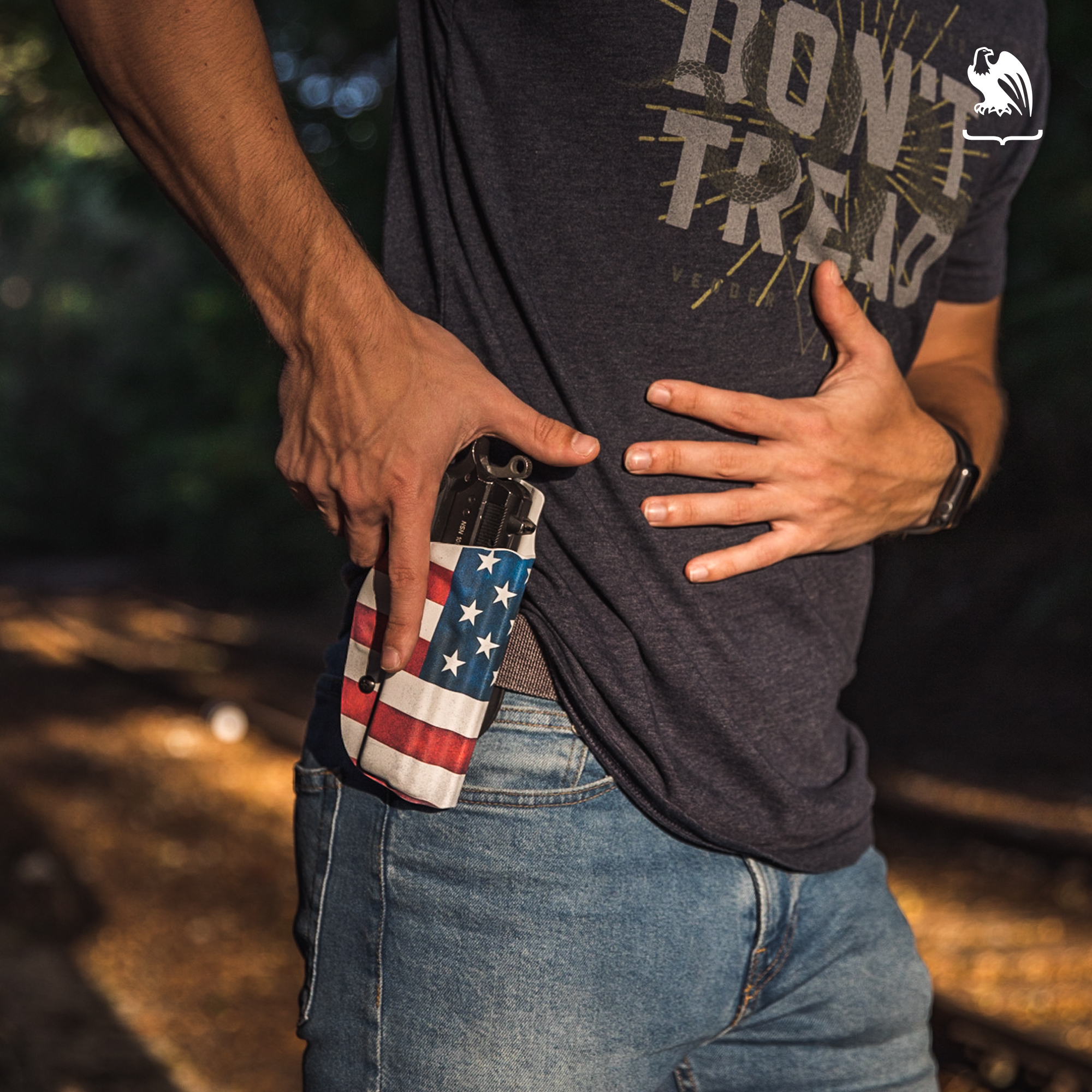
Drawing from outside the waistband is simple. If you’re open carrying, you’ll find it’s the easiest way to draw since nothing stands between you and your pistol. If you’re concealing an OWB holster, however, there are a few things to consider.
If you’re using a coat, jacket, or other layers to hide your OWB holster, you’ll need to use your weak hand to move that garment out of the way while you draw with your dominant hand. This shouldn’t be any more difficult than drawing IWB unless the coat or jacket you’re wearing is heavy and harder to move out of the way.
This problem can be solved by choosing the right clothes for concealed carry. It may take some time to figure out what works, so it’s important to practice drawing from under different articles of clothing (with an unloaded gun of course) while at home so you don’t run into any surprises in the event you need to access your weapon.
And, speaking of training, your level of success when drawing OWB all comes down to how well and how often you train. Someone who wears three layers of clothing to conceal their pistol may still have a faster draw than someone open carrying if they practice their draw more consistently.
Dressing To Conceal Your OWB Holster
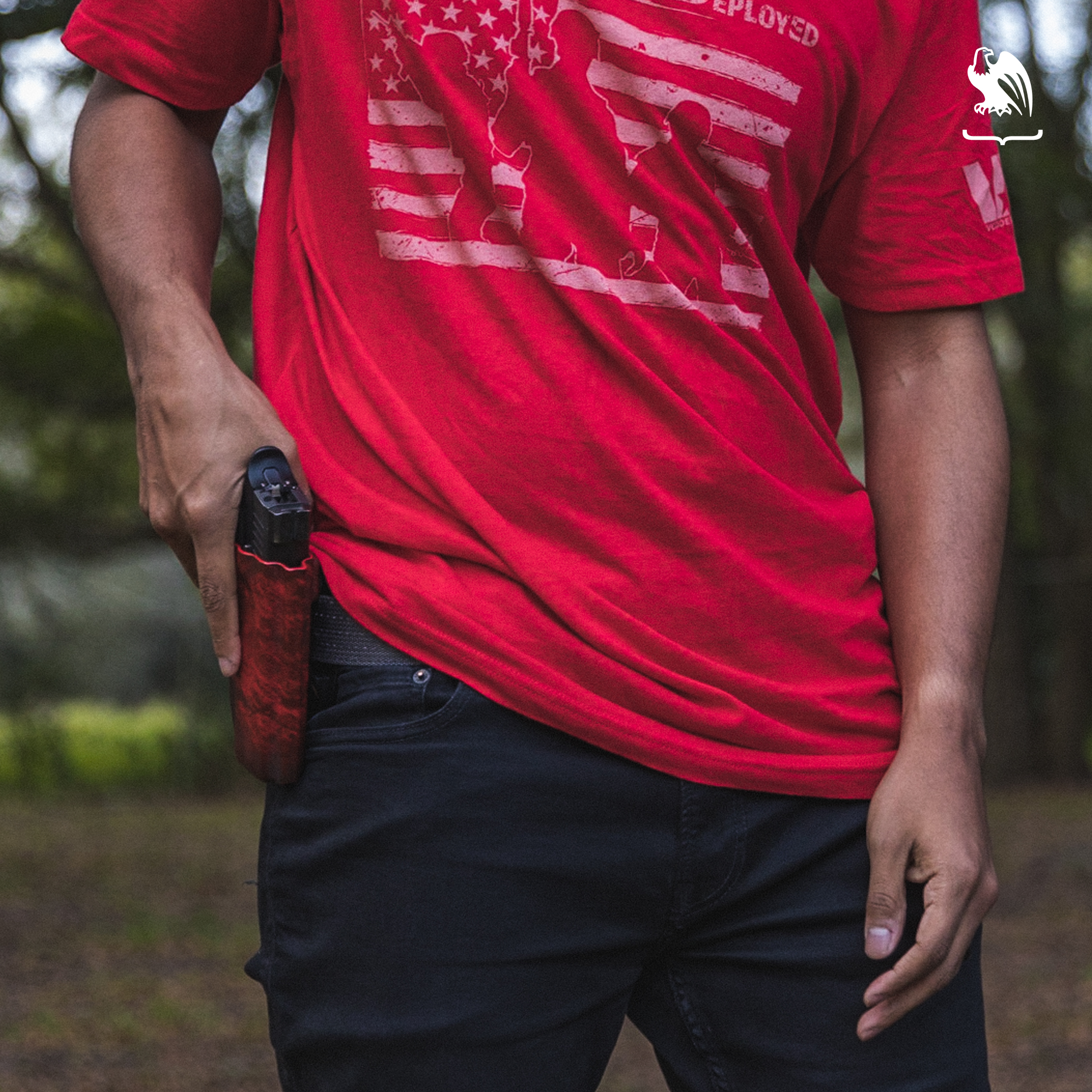
Successfully concealed carrying has everything to do with how you dress, which is especially true when it comes to outside the waistband carry.
In cold weather, concealing an OWB holster is easy. If you live in a cold enough climate, you’re probably already wearing extra layers like vests, flannels, and jackets, which can easily hide an outside the waistband setup. More layers means less printing, and the thicker the clothes, the better.
One thing to keep in mind is if you’re relying on a coat or a jacket to conceal your firearm, you’ll need to keep it on inside places like stores and restaurants if you want to keep your gun covered. That’s where lighter layers, like flannels and vests, come in handy.
In the summertime, concealing OWB can get a bit tricky, but not impossible.
Lighter button-up shirts (think fishing shirts, Hawaiian shirts, and other loose, lightweight button-ups) that can be worn over an undershirt are handy for concealing weapons. Opting for darker colors or patterns can also help reduce printing.
The best way to figure out what works to conceal your carry system is experimentation. Try out a few things in your closet to see if they work, and, if not, a trip to the mall (or your local sporting goods store) may be in order.
Do I Need A Gun Belt For OWB Carry?
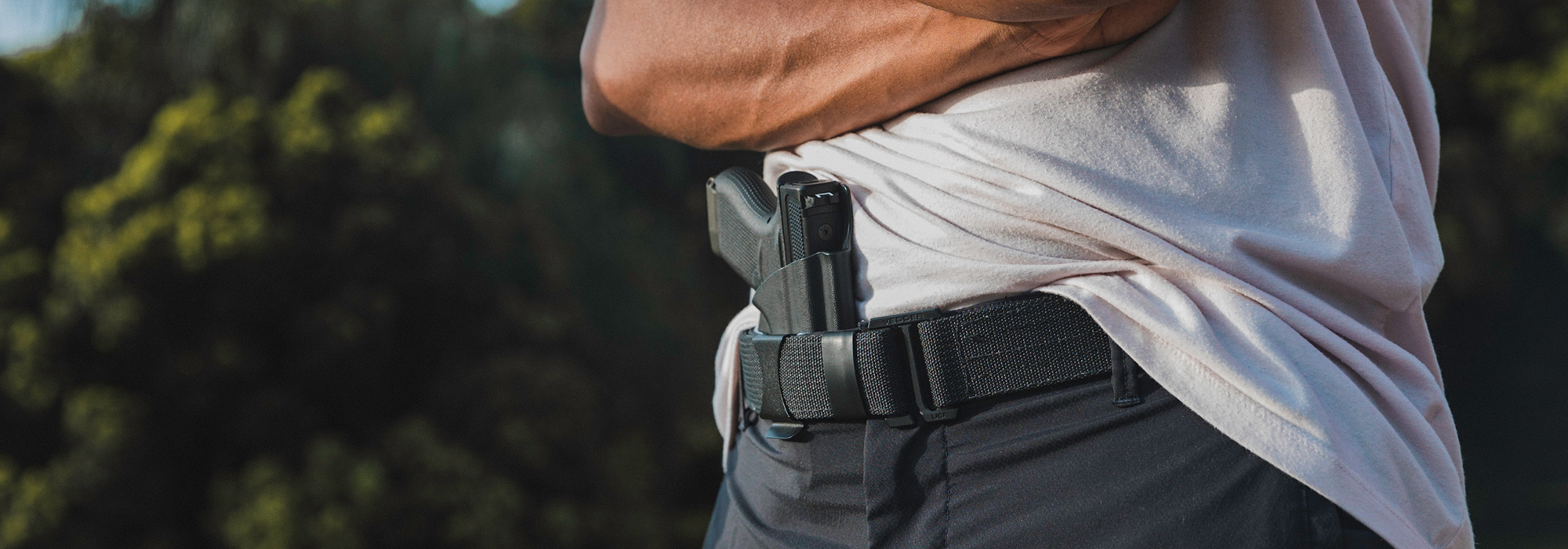
If you’ve read enough of our articles, you probably know by now that the answer to whether you need a gun belt for concealed carry is yes, yes you do.
Can you use a regular belt for concealed carry? Sure. As long as you don’t mind your belt sagging and your firearm slipping into an uncomfortable position where it could cause printing, or worse, shifting so that it’s not in the right place when you need it.
Regular belts are simply not designed to support the weight of your carry system. Gun belts, on the other hand, are specifically made thicker, stiffer, and more durable so that when you go to take your belt and pistol off at the end of the day, they’re exactly where you put them.
Investing in a quality gun belt is especially important when carrying outside the waistband, as they can help keep your weapon nice and close to your body, making it easier to conceal.
When selecting a gun belt for your carry system, there are a few things to keep in mind:
Stiffness: If you’re trying to prevent sagging, it goes without saying that your gun belt needs to be stiff enough to support your pistol, holster, and whatever else you carry. Most concealed carry gun belts are crafted with high-quality materials and/or a solid core to withstand a great deal of weight.
Thickness: Equally as important as the stiffness of your belt is its thickness. If your belt is too thin, your holster won’t properly clip to it and may slide around or even fall off. On the other hand, if your belt is too thick your holster may not be able to clip to it at all. Finding a gun belt with the right thickness can go a long way in ensuring a comfortable and successful experience.
Material: Most gun belts on the market are made from either nylon or leather. While obviously different, both of these options work well for supporting your CCW rig. Leather gun belts, like our Polymer Core Leather Gun Belt, are typically designed with multiple layers of leather that encompass a polymer or other type of core. Nylon belts, on the other hand, are designed with thick webbed nylon and are typically used for more tactical purposes.
Buckle: When it comes to gun belts, the buckle is an important feature. Leather belts often have a standard belt buckle while nylon belts, like our Cobra® Belt, sometimes come with quick-release buckles. Other options, like our V3 Belt, are more low-profile while still being user-friendly.
To learn more about gun belts and how to choose the best one for you, check out our deep dive on the subject here.
How Long Should I Test An OWB Setup?
It takes time to get used to a new carry system. Even the best OWB holster for concealed carry can feel foreign and intimidating at first, especially if other factors make it uncomfortable.
Even if you’ve found the best concealed carry position for your OWB holster, it may take a few weeks or so to adjust it correctly. It also takes time to get used to carrying and drawing from outside the waistband if you’re not used to it.
We recommend testing an OWB carry position for at least a couple of days to give it a real chance before giving up on it. If anything feels awkward or uncomfortable, make a few small changes to see if that helps. If your holster has adjustable cant, like our Vedder Holsters ProDraw™ Paddle Holster, play around with different angles until you find one that works.
If you’ve done your due diligence with a carry position and still don’t like it for some reason, use what you learned from your first try and give another position a shot.
Once you have found a position that you like, it’s crucial that you stick with your choice and consistently practice carrying and drawing from that position. You want to fine-tune your draw and build muscle memory so that in the event you’re faced with a defensive encounter, you’ll be quick to react appropriately.
Summary
An outside the waistband holster is a great choice for anyone looking to start concealed carrying for the first time or for those trying to carry a larger pistol. They are known for being one of the safest and most comfortable carry options.
There are a variety of holster types and carry positions to consider when learning how to wear OWB holster for concealed carry. The best option for you will depend on your lifestyle, level of comfort, and personal preference.
You can check out our entire collection of Vedder Holsters OWB Kydex holsters here.
If you are looking for belts or other types of holsters, check out some of our Vedder Holsters products here. Like everything we sell, our holsters and gun belts are covered by a Lifetime Warranty and a 30-day money-back guarantee.
Looking for items beyond holsters and belts? Check out our Resources Page for popular product links like lights, lasers, first aid, maintenance, and more.


